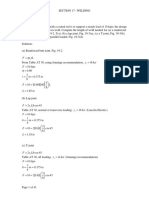0 ratings0% found this document useful (0 votes)
241 viewsG 32.05 Ft/s Z: F 12000 LBF 32.05 Ft/s 32.174 LB Ft/s 1 LBF
G 32.05 Ft/s Z: F 12000 LBF 32.05 Ft/s 32.174 LB Ft/s 1 LBF
Uploaded by
Single UserA 12,000 lbf construction crane fell from a height of 400 feet to the street below during a storm. The mass of the crane was calculated to be 12,046 lb using the given gravitational acceleration of 32.05 ft/s^2. The change in gravitational potential energy of the crane was determined to be 4.8 x 10^6 ft∙lbf by multiplying the crane's weight by the change in elevation.
Copyright:
© All Rights Reserved
Available Formats
Download as PDF, TXT or read online from Scribd
G 32.05 Ft/s Z: F 12000 LBF 32.05 Ft/s 32.174 LB Ft/s 1 LBF
G 32.05 Ft/s Z: F 12000 LBF 32.05 Ft/s 32.174 LB Ft/s 1 LBF
Uploaded by
Single User0 ratings0% found this document useful (0 votes)
241 views1 pageA 12,000 lbf construction crane fell from a height of 400 feet to the street below during a storm. The mass of the crane was calculated to be 12,046 lb using the given gravitational acceleration of 32.05 ft/s^2. The change in gravitational potential energy of the crane was determined to be 4.8 x 10^6 ft∙lbf by multiplying the crane's weight by the change in elevation.
Original Description:
Original Title
Thermo q4
Copyright
© © All Rights Reserved
Available Formats
PDF, TXT or read online from Scribd
Share this document
Did you find this document useful?
Is this content inappropriate?
A 12,000 lbf construction crane fell from a height of 400 feet to the street below during a storm. The mass of the crane was calculated to be 12,046 lb using the given gravitational acceleration of 32.05 ft/s^2. The change in gravitational potential energy of the crane was determined to be 4.8 x 10^6 ft∙lbf by multiplying the crane's weight by the change in elevation.
Copyright:
© All Rights Reserved
Available Formats
Download as PDF, TXT or read online from Scribd
Download as pdf or txt
0 ratings0% found this document useful (0 votes)
241 views1 pageG 32.05 Ft/s Z: F 12000 LBF 32.05 Ft/s 32.174 LB Ft/s 1 LBF
G 32.05 Ft/s Z: F 12000 LBF 32.05 Ft/s 32.174 LB Ft/s 1 LBF
Uploaded by
Single UserA 12,000 lbf construction crane fell from a height of 400 feet to the street below during a storm. The mass of the crane was calculated to be 12,046 lb using the given gravitational acceleration of 32.05 ft/s^2. The change in gravitational potential energy of the crane was determined to be 4.8 x 10^6 ft∙lbf by multiplying the crane's weight by the change in elevation.
Copyright:
© All Rights Reserved
Available Formats
Download as PDF, TXT or read online from Scribd
Download as pdf or txt
You are on page 1of 1
Problem 2.
A construction crane weighing 12,000 lbf fell from a height of 400 ft to the street below during a
severe storm. For g = 32.05 ft/s2, determine mass, in lb, and the change in gravitational potential
energy of the crane, in ft∙lbf.
KNOWN: A crane of known weight falls from a known elevation to the street below.
FIND: Determine the change in gravitational potential energy of the crane.
SCHMATIC AND GIVEN DATA:
Fgrav = 12,000 lbf
g = 32.05 ft/s2
z2 = 0
z1 = 400 ft
ENGINEERING MODEL: (1) The crane is the closed system. (2) The acceleration of gravity
is constant.
ANALYSIS:
To get the mass, note that Fgrrav = mg. Thus
Fgrav 12000 lbf 32.174 lb∙ft/s2
𝑚= = 2
| | = 12,046 lb
𝑔 32.05 ft/s 1 lbf
The change in gravitational potential energy is
∆𝑃𝐸 = 𝑚𝑔(𝑧2 − 𝑧1 ) = Fgrav ∆𝑧 = (12000 lbf)(−400 ft) = 4.8 x 106 ft ∙ lbf
You might also like
- Pete CircuitsDocument41 pagesPete CircuitsRome Erwin Manalo FestinNo ratings yet
- Problem 12. Structural Design "CE Board Exam Nov. 1992Document1 pageProblem 12. Structural Design "CE Board Exam Nov. 1992Alvin0% (2)
- Assignment Open and Closed Thermodynamic SystemDocument1 pageAssignment Open and Closed Thermodynamic SystemJenellie BahintingNo ratings yet
- Me 313b Fluid Machineries Module Week 10 13 PDF FreeDocument60 pagesMe 313b Fluid Machineries Module Week 10 13 PDF FreeChris TopherNo ratings yet
- BSABE2 - Blasquez - Lab Report 2Document7 pagesBSABE2 - Blasquez - Lab Report 2Lorenzo Niño BlasquezNo ratings yet
- Ac/Dc Machineries: A Study Guide and Module For Third Year BSME Students of SlsuDocument58 pagesAc/Dc Machineries: A Study Guide and Module For Third Year BSME Students of Slsuosas pasasNo ratings yet
- 39Document1 page39Edbert TulipasNo ratings yet
- 1.MEET 315LA MatScie Engineering ME Lab Module 1Document59 pages1.MEET 315LA MatScie Engineering ME Lab Module 1Cj TilamNo ratings yet
- Hybrid Street LightDocument8 pagesHybrid Street LightStephanie MarquezNo ratings yet
- ModuleDocument37 pagesModuleAlvin RazoNo ratings yet
- Act 1 Engineering Economics Group 6Document3 pagesAct 1 Engineering Economics Group 6Charlie Ercole Mercado100% (1)
- What Would Be Its FrequencyDocument1 pageWhat Would Be Its FrequencyMark AgusNo ratings yet
- Fluid Mechanics: Lecture 1: Introduction and Properties of FluidsDocument19 pagesFluid Mechanics: Lecture 1: Introduction and Properties of FluidsEleanor Caguimbal100% (1)
- Eastern Visayas State University-Ormoc City CampusDocument3 pagesEastern Visayas State University-Ormoc City Campuskhellian villameroNo ratings yet
- Compiled FluMach Problems - GROUP6 - BSME31Document58 pagesCompiled FluMach Problems - GROUP6 - BSME31Jhun Briones100% (1)
- Thermodynamics 1: Prepared byDocument105 pagesThermodynamics 1: Prepared byReyven Recon100% (1)
- Engineering Math and SciencesDocument227 pagesEngineering Math and SciencesMercy Joy PangadloNo ratings yet
- Module 2.4 Enthalpy and 2ND Corollary of 1ST LawDocument6 pagesModule 2.4 Enthalpy and 2ND Corollary of 1ST LawsubyNo ratings yet
- Midterm Practice Prob 1Document1 pageMidterm Practice Prob 1Kevin NavidadNo ratings yet
- PulleysDocument8 pagesPulleysMuhammad Averoes0% (1)
- T MEET324LA - Experiment - No.6 - Measurement of Velocity and Pressure With Manometer - Group5 - MEE31Document11 pagesT MEET324LA - Experiment - No.6 - Measurement of Velocity and Pressure With Manometer - Group5 - MEE31Paul Ryan GeneralNo ratings yet
- ANNEX III - Course Specificationfor MEDocument54 pagesANNEX III - Course Specificationfor MErollramsNo ratings yet
- Basic Concepts of Vibrating SystemDocument14 pagesBasic Concepts of Vibrating SystemElisif DeFairNo ratings yet
- Linx JCSF Mathematics (Problems and Elements)Document38 pagesLinx JCSF Mathematics (Problems and Elements)cledcel15No ratings yet
- Design Procedure For Flat BeltDocument2 pagesDesign Procedure For Flat BeltKutty AravindNo ratings yet
- Motors Engines TransparencyDocument9 pagesMotors Engines Transparencystephene larimNo ratings yet
- MODULE 2 Lesson 1Document12 pagesMODULE 2 Lesson 1zyx xyzNo ratings yet
- D. Her Mass Moment of Inertia Is Reduced: 1-Point QuestionsDocument21 pagesD. Her Mass Moment of Inertia Is Reduced: 1-Point QuestionsShinNo ratings yet
- AIR CONDITIONING AND VENTILATION SYSTEM Prelim ExamDocument1 pageAIR CONDITIONING AND VENTILATION SYSTEM Prelim ExamJames Patrick TorresNo ratings yet
- College Algebra For Engineering and Allied SciencesDocument10 pagesCollege Algebra For Engineering and Allied SciencesRemington SalayaNo ratings yet
- Chapter 1 14febDocument28 pagesChapter 1 14febJoo LimNo ratings yet
- Section 17Document41 pagesSection 17Mark EstepaNo ratings yet
- Meen 30133 Machine ElementsDocument64 pagesMeen 30133 Machine ElementserickaNo ratings yet
- Gas CyclesDocument15 pagesGas CyclesVincent LagunillaNo ratings yet
- Heat Transfer: Precious Arlene Villaroza-MelendrezDocument33 pagesHeat Transfer: Precious Arlene Villaroza-MelendrezMark Jake RodriguezNo ratings yet
- Experiment 2 HORSEPOWER EFFICIENCY GEAR RATIO AND SPEED RATIODocument10 pagesExperiment 2 HORSEPOWER EFFICIENCY GEAR RATIO AND SPEED RATIOJake Polo SantiagoNo ratings yet
- ProblemsDocument3 pagesProblemsimPERFECTme09No ratings yet
- Ass No. 3Document2 pagesAss No. 3Ako C. IvanNo ratings yet
- Mech 223Document9 pagesMech 223DavidIbones VEVONo ratings yet
- Chapter IDocument37 pagesChapter IeyobNo ratings yet
- PME9 Heat TransferDocument8 pagesPME9 Heat TransferKAL ELNo ratings yet
- Reynolds Number ProblemsDocument2 pagesReynolds Number ProblemsRodrigo Pacheco50% (2)
- Chapter 4Document14 pagesChapter 4Anthony Leire MontealtoNo ratings yet
- Ideal Gas Examples (Quest) Part 4.1Document1 pageIdeal Gas Examples (Quest) Part 4.1Chloe OlazoNo ratings yet
- Otto Cycle and Diesel Cycle - MEENG324Document15 pagesOtto Cycle and Diesel Cycle - MEENG324King Cyruz PabloNo ratings yet
- CO Assign#2 BSEE-2ADocument3 pagesCO Assign#2 BSEE-2AEisen JaylordNo ratings yet
- ME ThermodynamicsDocument58 pagesME ThermodynamicsprasobhaNo ratings yet
- MD - Chapter 4Document2 pagesMD - Chapter 4JohnNo ratings yet
- Me Review: Von Eric A. Damirez, M.SCDocument25 pagesMe Review: Von Eric A. Damirez, M.SCKhate ÜüNo ratings yet
- Fluid DynamicsDocument70 pagesFluid DynamicsH Aries OñaNo ratings yet
- Mechanics (Dynamics)Document2 pagesMechanics (Dynamics)Earl JennNo ratings yet
- UntitledDocument10 pagesUntitledRyle and Rael TalksNo ratings yet
- Problem No.2 Conduction Through Cylindrical PipeDocument3 pagesProblem No.2 Conduction Through Cylindrical Pipeariel darisanNo ratings yet
- Case 6666666666666666Document8 pagesCase 6666666666666666Erish Ken DomingoNo ratings yet
- ShaftingDocument7 pagesShaftingMico CampoNo ratings yet
- Thermodynamics Lesson 1-5Document43 pagesThermodynamics Lesson 1-5Cristel Shane DuranNo ratings yet
- Work, Energy and PowerDocument32 pagesWork, Energy and PowerHahahahahahahahahaNo ratings yet
- Thermo q5Document1 pageThermo q5Single UserNo ratings yet
- Work/Energy Practice Problems: For Q1 OnlyDocument4 pagesWork/Energy Practice Problems: For Q1 Only(25) Sena GuzelsevdiNo ratings yet



























































